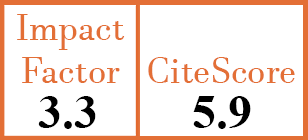Full Papers
Equivalent cut-off values of Bath Ankylosing Spondylitis Disease Activity Index corresponding to Ankylosing Spondylitis Disease Activity Score cut-off values
R. Cui1, Y. Du2, N. Tian3, H.-L. Jiang4, Y.-L. Tao5, S.-M. Dai6
- Department of Rheumatology and Immunology, Shanghai Jiao Tong University Affiliated Sixth People's Hospital, Shanghai, China.
- Department of Rheumatology and Immunology, Shanghai Jiao Tong University Affiliated Sixth People's Hospital, Shanghai, China.
- Department of Rheumatology and Immunology, Shanghai Jiao Tong University Affiliated Sixth People's Hospital, Shanghai, China.
- Department of Rheumatology and Immunology, Shanghai Jiao Tong University Affiliated Sixth People's Hospital, Shanghai, China.
- Department of Rheumatology and Immunology, Shanghai Jiao Tong University Affiliated Sixth People's Hospital, Shanghai, China.
- Department of Rheumatology and Immunology, Shanghai Jiao Tong University Affiliated Sixth People's Hospital, Shanghai, China. shengmingdai@163.com
CER16001
2023 Vol.41, N°5
PI 1163, PF 1169
Full Papers
PMID: 36226617 [PubMed]
Received: 29/06/2022
Accepted : 29/09/2022
In Press: 12/10/2022
Published: 03/05/2023
Abstract
OBJECTIVES:
To define the equivalent cut-off values of Bath ankylosing Spondylitis Disease Activity Index (BASDAI) for discriminating disease activity corresponding to Ankylosing Spondylitis Disease Activity Score (ASDAS) cut-off values, and to determine the equivalent change units for determining the clinically improvement between ΔBASDAI and ΔASDAS-CRP.
METHODS:
475 patients with axial spondyloarthritis (axSpA) whose data on BASDAI and ASDAS were available were included. Among them, 154 (32.4%) patients whose data on ΔBASDAI and ΔASDAS-CRP were available. Receiver-operator curve (ROC) with area under curve (AUC) was used to determine the BASDAI cut-off values that best corresponded to ASDAS-CRP. The Cohen’s kappa was utilised to assess the degree of agreement between disease activity states based on BASDAI and ASDAS cut-off values, and clinically improvement between ΔBASDAI and ΔASDAS-CRP.
RESULTS:
According to the ASDAS-CRP, 88 (18.6%), 130 (27.4%), 191 (40.1%) and 66 (13.9%) patients were classified as inactive, moderate, high and very high disease activities, respectively. ROC revealed that BASDAI values 1.6 (AUC: 0.948), 2.9 (AUC: 0.790) and 3.8 (AUC: 0.875) best corresponded to ASDAS-CRP values 1.3, 2.1 and 3.5, respectively. The degree of agreement between them was moderate (kappa: 0.527). The ΔBASDAI 1.6 (AUC: 0.745) and 2.0 (AUC: 0.708) best corresponded to the ΔASDAS-CRP 1.1 (minimal clinically important improvement) and 2.0 (major improvement), respectively. The degree of agreement was good (kappa: 0.685).
CONCLUSIONS:
The BASDAI values 1.6, 2.9 and 3.8 correspond to ASDAS-CRP values 1.3, 2.1 and 3.5, respectively. The ΔBASDAI 1.6 and 2.0 best correspond to the ΔASDAS-CRP 1.1 and 2.0, respectively.



